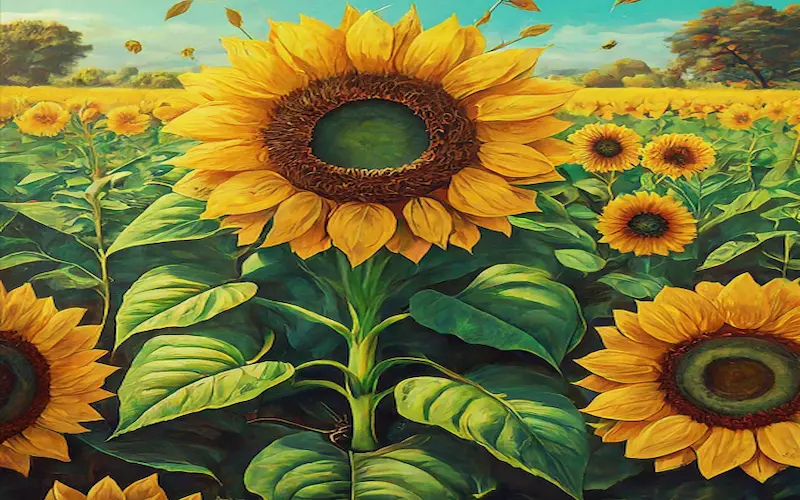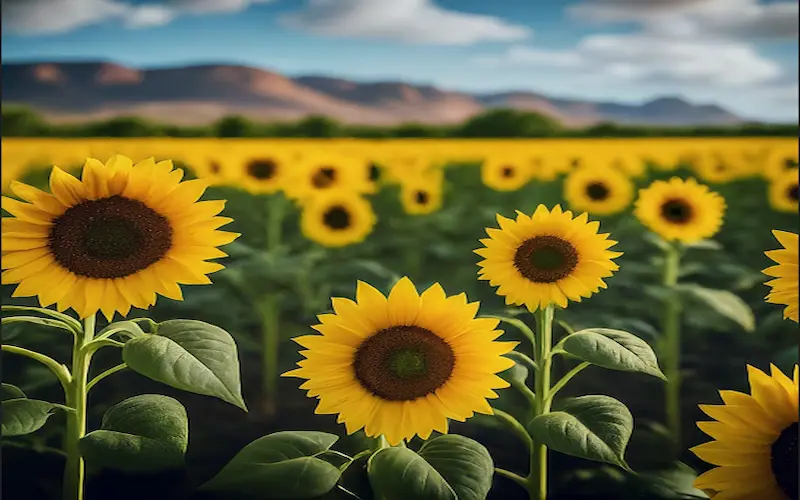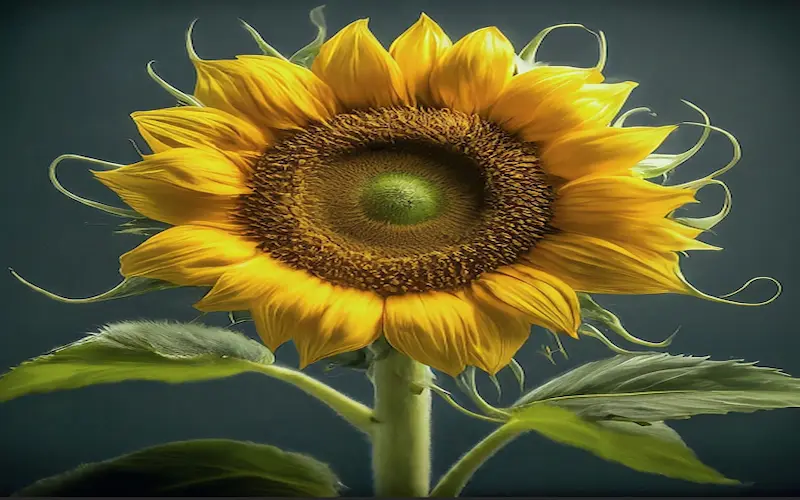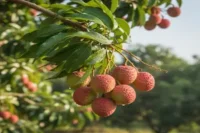5 Growing Stages of Sunflowers: A Step-by-Step Guide
Published: 5 Jan 2025
Sunflowers are the most rewarding plants. They have vibrant yellow petals and a towering stature. Sunflower shoots are a microgreen favorite for their nutty flavor. Discover how to use them in our microgreen salad recipe collection!”
Understanding all sunflower growth stages is necessary to get the maximum yield per acre. Basil and dill are the best companion plants for sun flower.
This comprehensive guide will educate you about all the growing stages of sunflowers, from germination to harvest. I will also teach you about factors affecting growth and the secrets of successful cultivation.

Importance of understanding sunflower growth Stages
Understanding how sunflowers grow is important for a few reasons:
- Better Harvest: Understanding the growth process helps us make smart choices, leading to a better and more plentiful sunflower harvest
- Spot Problems Early: Knowing each growth stage helps us identify and fix issues quickly, keeping plants healthy.
- Give the Right Care: We can provide the right care at the right time, based on what sunflowers need at each stage.
Germination
The first stage in the sunflower’s life cycle is germination. In this stage, the seed is planted in moist, well-draining soil at the appropriate depth and temperature. The seed absorbs water and swells, and the embryo awakens, sending out a tiny root called the radicle. Shortly after, the shoot emerges, pushing its way through the soil towards the sunlight.
During this stage, it’s crucial to maintain consistent soil moisture and protect the seedlings from pests and extreme weather conditions. Proper spacing between seeds is also essential to prevent overcrowding and ensure optimal growth.

Seedling Growth
Once the sunflower seedling has emerged from the soil, it enters the seedling growth stage. During this phase, the plant focuses its energy on developing its first set of true leaves, known as the cotyledons. These leaves are responsible for photosynthesis, providing the seedling with the necessary nutrients for growth.
As the seedling matures, it will develop additional leaves and a sturdy stem. Proper sunlight exposure, adequate water, and nutrient-rich soil are vital to promote robust seedling development during this stage.

Vegetative Growth
After the seedling stage, the sunflower plant rapidly grows upward and expands outward, which is called the vegetative growth stage. During this phase, the plant directs its energy toward developing a solid stem, large green leaves, and an extensive root system.
As the sunflower grows taller, it may require staking or support to prevent it from toppling over. Consistent watering and fertilization are essential during this stage to fuel the plant’s vigorous growth. Monitoring for pests and diseases that could hinder the sunflower’s development is necessary.

Flowering
The flowering stage is the most anticipated and visually stunning phase of the life cycle for sunflowers. As the plant matures, a bud forms at the top of the stem, gradually opening to reveal the iconic yellow petals surrounding a dense centre of tiny florets.
During this stage, the sunflower actively seeks out pollinators like bees and butterflies to facilitate cross-pollination and ensure seed production. Adequate sunlight and water are crucial for the successful development of the flower head and subsequent seed formation.

Seed Production and Maturity
The final stage of the sunflower’s growth is seed production and maturity. Once the flower has been pollinated, the petals will wilt and dry up. This is the start of seed development. The seeds are packed with essential nutrients. They will gradually mature and ripen within the flower head.
As the seeds reach maturity, the back of the sunflower head will turn yellow or brown. This indicates that it’s time for harvesting. During this stage, it is essential to monitor the sunflower closely and protect it from birds and other pests that may try to feast on the seeds.
Harvesting and storing sunflower seeds
As the sunflower heads mature and the back of the flower turns yellow or brown, it’s time to harvest the seeds. Here’s how to do it:
1. Cutting the heads: Use a sharp knife or pruning shears to cut the sunflower heads off the stems, leaving about 6 inches (15 cm) of stem attached.
2. Drying the heads: Place the harvested sunflower heads in a warm, dry, and well-ventilated area, such as a greenhouse or covered patio. Allow them to dry for 2-3 weeks until the backs of the heads turn brown and the seeds are easily dislodged.
3. Removing the seeds: Once thoroughly dried, gently rub the back of the sunflower head over a clean surface or container to release the seeds. Discard any damaged or shriveled seeds.
4. Storing the seeds: Store the sunflower seeds in an airtight container in a cool, dry place. Properly stored, the seeds can last for several months or even a year.
Factors Affecting the Life Cycle of a Sunflower
While understanding the sunflower growing stages is crucial, it’s also important to recognize the various factors that can influence the plant’s development. These include:
- Soil quality: Sunflowers thrive in well-draining, nutrient-rich soil with a slightly acidic to neutral pH. Poor soil conditions can lead to stunted growth and reduced yields.
- Sunlight exposure: As their name suggests, sunflowers require ample sunlight, ideally at least 6-8 hours of direct sunlight per day. Insufficient sunlight can result in weak stems and reduced flowering.
- Water availability: A Consistent and adequate water supply is essential throughout the sunflower’s growth stages. Overwatering or underwatering can both have detrimental effects on the plant’s health and development.
- Temperature: Sunflowers prefer warm temperatures, typically between 70°F and 85°F (21°C and 29°C). Extreme heat or cold can stress the plant and impact its growth.
- Pests and diseases: Various pests, such as aphids, sunflower moths, and birds, as well as diseases like downy mildew and rust, can pose threats to sunflower growth. Regular monitoring and appropriate control measures are necessary.
Tips for successful sunflower growing.
To ensure a bountiful and healthy sunflower crop, here are some valuable tips to keep in mind:
1. Choose the suitable variety: Select sunflower varieties suited to your climate and growing conditions. Consider factors like plant height, maturity time, and disease resistance.
2. Prepare the soil: Amend it with compost or well-rotted manure to improve nutrient content and drainage. Proper soil preparation is essential for strong root development.
3. Plant at the right time: Sunflowers are warm-season annuals, so it’s best to plant them after the last frost date in your area. Consult local planting guides or experienced gardeners for optimal timing.
4. Provide support: As sunflowers grow tall, they may require staking or caging to prevent them from toppling over, especially in windy conditions.
5. Mulch around the plants: Applying a layer of organic mulch around the sunflower plants helps retain soil moisture, suppress weeds, and regulate soil temperature.
6. Practice crop rotation: Rotate the location of your sunflower patch each year to prevent soil-borne diseases and pests from accumulating.
7. Monitor and maintain: Regularly inspect your sunflower plants for signs of pests, diseases, or nutrient deficiencies. Address any issues promptly to ensure optimal growth and development.
Common problems and troubleshooting
Despite our best efforts, sunflower growers may encounter various challenges throughout the growing process. Here are some common problems and troubleshooting tips:
1. Stunted growth: If your sunflowers are not growing as expected, check for nutrient deficiencies, inadequate water, or pest infestations. Amend the soil with compost or fertilizer, adjust watering schedules, and inspect for pests.
2. Yellowing leaves can indicate nutrient deficiencies, particularly nitrogen or iron. Apply a balanced fertilizer or chelated iron supplement to address the issue.
3. Pests and diseases: Regularly monitor your sunflowers for signs of aphids, sunflower moths, or diseases like downy mildew or rust. Implement appropriate control measures, such as insecticidal soaps, neem oil, or fungicides, as needed.
4. Lodging (falling over): If your sunflowers are toppling over, it could be due to strong winds, heavy flower heads, or poor root development. Stake or cage the plants for support and ensure adequate soil preparation and watering.
5. Poor pollination: Inadequate pollination can reduce seed production. To attract pollinators like bees and butterflies to your garden, plant companion flowers and avoid excessive pesticide use.
Conclusion
Cultivating sunflowers is a rewarding experience for any gardener. By understanding the five main stages of sunflower growth—germination, seedling growth, vegetative growth, flowering, and seed production—and addressing the factors influencing their development, you can ensure a successful and bountiful harvest.
It is also necessary to choose a suitable variety, prepare the soil adequately, plant at the optimal time, and provide the required support, water, and nutrients throughout the growing process. Regular monitoring and prompt action against pests and diseases are also crucial for maintaining the health and vigor of your sunflower plants.

- Be Respectful
- Stay Relevant
- Stay Positive
- True Feedback
- Encourage Discussion
- Avoid Spamming
- No Fake News
- Don't Copy-Paste
- No Personal Attacks



- Be Respectful
- Stay Relevant
- Stay Positive
- True Feedback
- Encourage Discussion
- Avoid Spamming
- No Fake News
- Don't Copy-Paste
- No Personal Attacks



